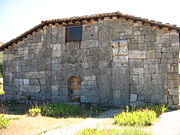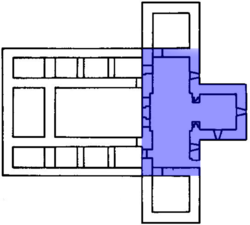
Santa Maria de Lara
Encyclopedia

Hermitage (religious retreat)
Although today's meaning is usually a place where a hermit lives in seclusion from the world, hermitage was more commonly used to mean a settlement where a person or a group of people lived religiously, in seclusion.-Western Christian Tradition:...
) de Santa María, is one of the last surviving Visigoth
Visigoth
The Visigoths were one of two main branches of the Goths, the Ostrogoths being the other. These tribes were among the Germans who spread through the late Roman Empire during the Migration Period...
churches on the Iberian Peninsula
Iberian Peninsula
The Iberian Peninsula , sometimes called Iberia, is located in the extreme southwest of Europe and includes the modern-day sovereign states of Spain, Portugal and Andorra, as well as the British Overseas Territory of Gibraltar...
, located near the village of Quintanilla de las Viñas, not far from the city of Burgos
Burgos
Burgos is a city of northern Spain, historic capital of Castile. It is situated at the edge of the central plateau, with about 178,966 inhabitants in the city proper and another 20,000 in its suburbs. It is the capital of the province of Burgos, in the autonomous community of Castile and León...
, in the Castile and León
Castile and León
Castile and León is an autonomous community in north-western Spain. It was so constituted in 1983 and it comprises the historical regions of León and Old Castile...
region in Spain, it dates back from around the year 700, although archeologists have not yet confirmed a more precise date. The church is notable not only for its age and architectural
Architecture
Architecture is both the process and product of planning, designing and construction. Architectural works, in the material form of buildings, are often perceived as cultural and political symbols and as works of art...
type, but also because it is believed to contain the earliest representation of Christ
Christ
Christ is the English term for the Greek meaning "the anointed one". It is a translation of the Hebrew , usually transliterated into English as Messiah or Mashiach...
in Spanish religious art. It was classified as a national monument on November 25 1929.
Early history
The geographical area surrounding Santa María De Lara was populated by numerous Roman villaRoman villa
A Roman villa is a villa that was built or lived in during the Roman republic and the Roman Empire. A villa was originally a Roman country house built for the upper class...
e preceding the construction of the church. After the Visigoths had invaded the Iberian Peninsula (particularly the area we now know as Spain) and the Romans
Roman Empire
The Roman Empire was the post-Republican period of the ancient Roman civilization, characterised by an autocratic form of government and large territorial holdings in Europe and around the Mediterranean....
had left the area, they settled in Quintillana de las Vinas, and built the church of Santa María De Lara, around the beginning of the 8th century. Soon afterwards, in 711 AD, the Moors
Moors
The description Moors has referred to several historic and modern populations of the Maghreb region who are predominately of Berber and Arab descent. They came to conquer and rule the Iberian Peninsula for nearly 800 years. At that time they were Muslim, although earlier the people had followed...
invaded the Iberian Peninsula and Lara was abandoned as the populace fled north to the mountains
Picos de Europa
The Picos de Europa is a range of mountains 20 km inland from the northern coast of Spain, located in the Autonomous Communities of Asturias, Cantabria and Castile and León, forming part of the Cantabrian Mountains...
.
In the 9th century, during the Spanish Reconquista
Reconquista
The Reconquista was a period of almost 800 years in the Middle Ages during which several Christian kingdoms succeeded in retaking the Muslim-controlled areas of the Iberian Peninsula broadly known as Al-Andalus...
, the areas that were previously abandoned (such as Lara), were repopulated, although the buildings were largely in ruins. Santa María De Lara was neglected during the period of Moorish
Moors
The description Moors has referred to several historic and modern populations of the Maghreb region who are predominately of Berber and Arab descent. They came to conquer and rule the Iberian Peninsula for nearly 800 years. At that time they were Muslim, although earlier the people had followed...
rule, and therefore the church had to be rebuilt. A funerary stela that is now housed in the Museum of Burgos that has been studied by archeologists, is believed to record the date of the reconstruction of Santa María De Lara. It is inscribed with the letters DCCCC (...), and despite the only partial remnant of the date, it is widely believed that this refers to the year 902 (bearing in mind that the inscription adheres to the Spanish medieval dating system, from which 38 years must be subtracted to obtain the European chronological year).

In 1038, the church was donated to the nearby monastery of San Pedro de Arlanza and from then on the church began a gradual decline both in religious status and architectural stability. Undated documents from the Bishop
Bishop
A bishop is an ordained or consecrated member of the Christian clergy who is generally entrusted with a position of authority and oversight. Within the Catholic Church, Eastern Orthodox, Oriental Orthodox Churches, in the Assyrian Church of the East, in the Independent Catholic Churches, and in the...
ry of Burgos later refer to it as a 'hermitage'.' After that, the church was abandoned, and parts of the building collapsed and much of its ancient carvings
Wood carving
Wood carving is a form of working wood by means of a cutting tool in one hand or a chisel by two hands or with one hand on a chisel and one hand on a mallet, resulting in a wooden figure or figurine, or in the sculptural ornamentation of a wooden object...
and decoration was lost.
Discovery and modern history
In 1921, a local parish priest, was walking near Quintanilla de las Vinas, when he came across the remains of Santa María de Lara, forgotten since the early Middle AgesMiddle Ages
The Middle Ages is a periodization of European history from the 5th century to the 15th century. The Middle Ages follows the fall of the Western Roman Empire in 476 and precedes the Early Modern Era. It is the middle period of a three-period division of Western history: Classic, Medieval and Modern...
and hidden by thick bush. Don Bonifacio Zamora, the priest, strived to bring his discovery to the interest of historians and experts. However, until 1927, he was unsuccessful and the site was used simply as a corral
Corral
Corral is a town, commune and sea port in Los Ríos Region, Chile. It is located south of Corral Bay. Corral is best known for the forts of Corral Bay, a system of defensive batteries and forts made to protect Valdivia during colonial times. Corral was the headquarters of the system...
for livestock. In 1927, the church was finally brought to the attention of experts such as Helmut Schlunk, a notable German scholar, who, amongst others, visited this 'newly discovered' Visigoth church in order to research it.
After two years of studying the site, it was granted 'National Monument' status on 25 November 1929. Later, during the 1930s, extensive excavations were carried out that revealed a large amount of data that shows the area was inhabited from early times. The research undertaken in the 1920s and 1930s has given us almost all we know about the church today. Many of the artefact
Artifact (archaeology)
An artifact or artefact is "something made or given shape by man, such as a tool or a work of art, esp an object of archaeological interest"...
s uncovered, such as funerary stelae, dolmen
Dolmen
A dolmen—also known as a portal tomb, portal grave, dolmain , cromlech , anta , Hünengrab/Hünenbett , Adamra , Ispun , Hunebed , dös , goindol or quoit—is a type of single-chamber megalithic tomb, usually consisting of...
s and objects from Roman villa
Roman villa
A Roman villa is a villa that was built or lived in during the Roman republic and the Roman Empire. A villa was originally a Roman country house built for the upper class...
e, are now housed in the 'Museo Provincial de Burgos.'
Up until the 1970s, the church could only be reached by a local road, until Jesus Vicario Moreno, who looked after Santa María de Lara and showed it to visitors until his recent death, oversaw the construction of an asphalt
Asphalt
Asphalt or , also known as bitumen, is a sticky, black and highly viscous liquid or semi-solid that is present in most crude petroleums and in some natural deposits, it is a substance classed as a pitch...
road leading to the church from Quintanilla de las Vinas, where he lived. Tourism and visitors to the site have provided money to keep the church stable and protect it with projects such as the modern wooden roof. Numbers of visitors have increased significantly and in 1992, 8000 tourists were recorded to have visited the site.

Lady Flammola
Lady Flammola is mentioned in an inscription carved onto the right side of the triumphal archTriumphal arch
A triumphal arch is a monumental structure in the shape of an archway with one or more arched passageways, often designed to span a road. In its simplest form a triumphal arch consists of two massive piers connected by an arch, crowned with a flat entablature or attic on which a statue might be...
within the church of the church. Translations differ, but it is believed that the text, reading , meaning "Flammola, the least of the least, makes this promised offering to God". Another translation is: This small gift the Lady Flammola offers to God. Dona Lambra, as modern historians now refer to Lady Flammola, possibly ordered the restoration
Building restoration
Building restoration describes a particular treatment approach and philosophy within the field of architectural conservation. According the U.S...
of the church in the 10th century, and supported it with the money that she donated according to the inscription. However, there are numerous women dating from that period of time that bear the same name, so a more accurate dating of the inscription may reveal precisely who it was that ordered the restoration.
Fernán González family
Muniadona features in an early document from 967 AD, which records her giving a donation to the church. Muniadona was the mother of Count Fernán González of Castile (who at that point ruled over Castile).Fernán González of Castile, the first independent count of Castile, was closely linked to the church, which is evident for three reasons. First, he was a member of the influential Lara family, and shares his name with the church. He grew up in, and later commanded, the castle of Lara, which is visible from Santa María de Lara with favourable weather. He was buried in the monastery of San Pedro de Arlanza, which at that point owned Santa María de Lara.

